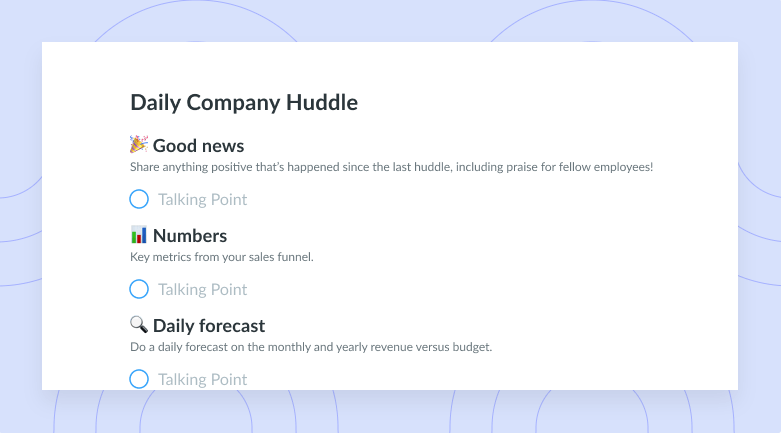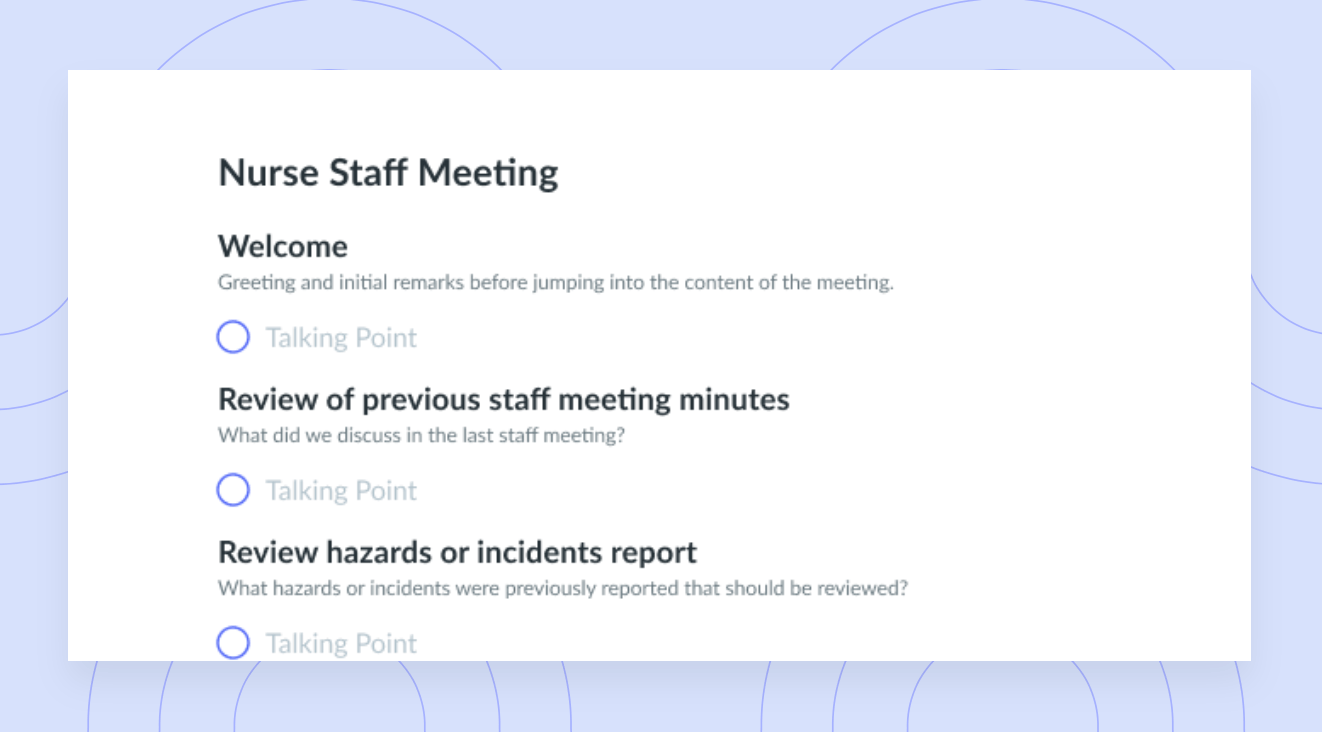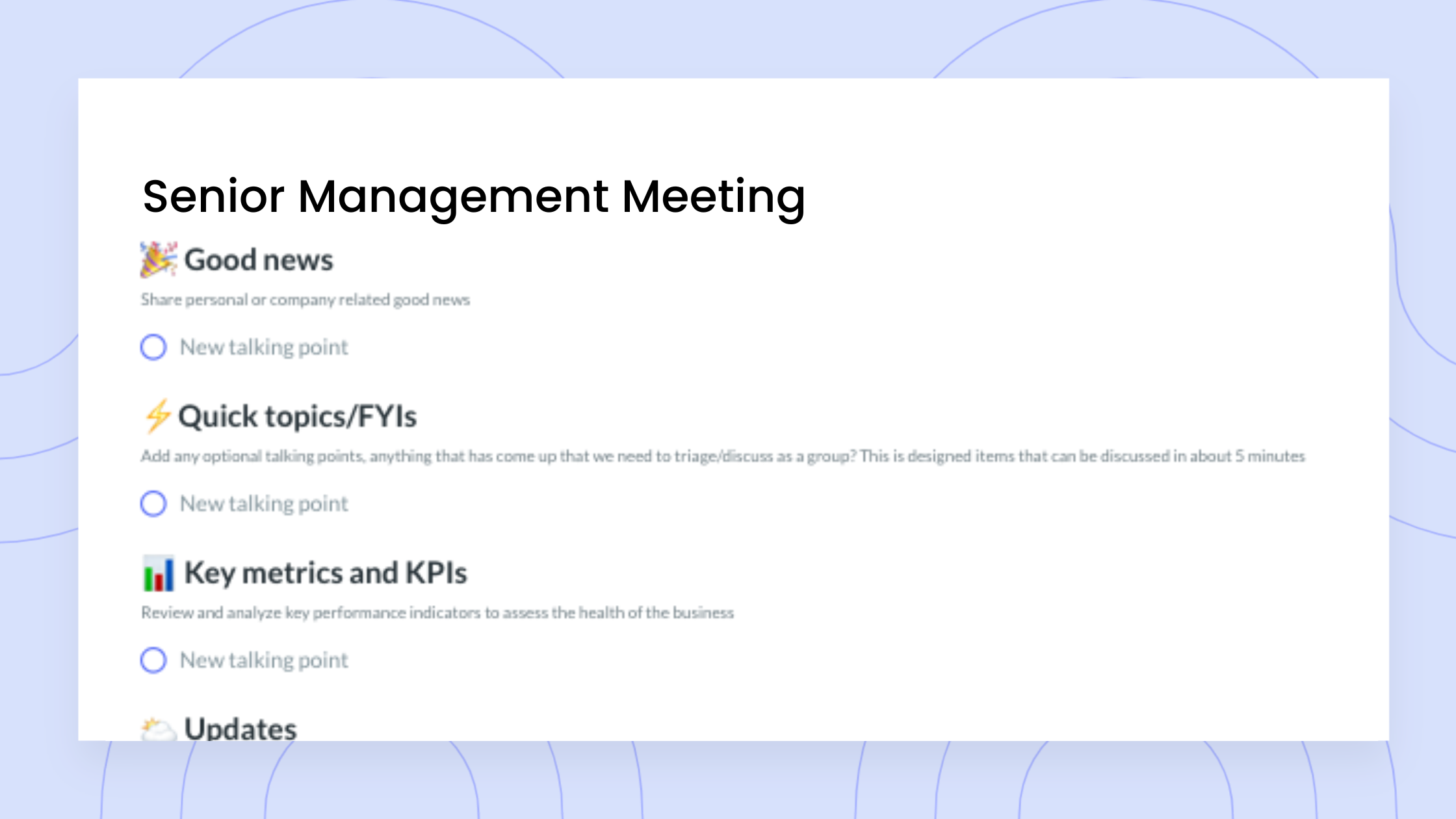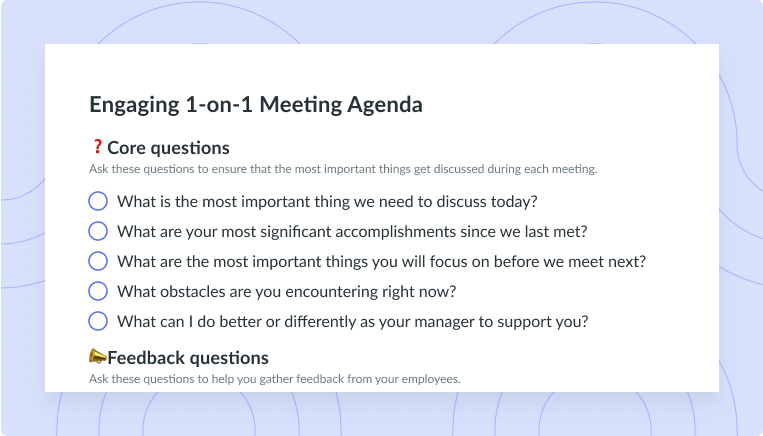How to start a meeting: 8 creative alternatives
Learn about some creative ways to open a conversation with your team, in order to keep employees engaged, interested and motivated.
We always hear about how important first impressions are. The same standard holds for the way in which you choose to start your meeting because it establishes the mood for the rest of the discussion. If participants are uninterested or disengaged after the first few minutes of a meeting, you’re going to experience an uphill battle in regaining employee’s attention. It’s all too common for leaders to start meetings in ineffective ways which fail to engage participants. For that reason, Fellow has put together some resources and ideas for how to start a meeting. We’ll take you through the importance of highlighting the purpose of the meeting, some ground rules, and how to hit every agenda item. To get started, keep scrolling!
The art of starting a meeting
The beginning of a meeting sets the mood for the rest of the conversation, which means the facilitator needs to be prepared and bring some good energy into the room (yes, even if it’s a virtual room). In a recent article by the Harvard Business Review, they emphasize how important it is to open your meeting effectively:
“You can usually tell within the first two minutes whether the meeting is going to be a good use of your time. If you’re running the show, make sure your meeting makes a great first impression by focusing everyone on the unique value they’re supposed to be adding, emphasizing diversity of thought, and filtering out time-sucks. Do that and you’ll find that your meetings earn a sterling reputation and actually help get work done.”
Following this advice, here are 8 ideas to open your meeting as effectively as possible.
8 Ideas to start your meeting on the right foot
1 Start with introductions
It’s always a good idea to start your meeting by introducing the participants and ensuring everyone is familiar with one another. This really helps people gain an understanding of who does what and where different employees participation is required, specifically. Instead of the facilitator making these introductions, it’s a lot more interesting to hear the information straight from the source. By asking employees to make their own introductions, you are encouraging engagement and allowing each individual to highlight their part in the project or discussion. Now, when questions and comments arise, they can be directed at the individuals who are responsible for that piece of the puzzle and they can use their expertise in the area to contribute to the conversation.
2 Celebrate wins and good news
Start the meeting on a high note, it will lighten the mood and make the employees feel good to be a part of the team’s success. Positivity is contagious, so even if it means opening with something great you saw on the news earlier that morning, something inspiring in the community or a personal funny story, the crowd will appreciate it. If you’re not tight on time, you can also ask others to share any positive news or any personal wins from that week, which is going to bring you and your team that much closer together.
3 Encourage shoutouts
Acknowledging good work and building up your employee’s professional esteem is going to further motivate individuals to perform well and ignite stronger engagement. Make sure to give praise where it’s been earned and thank employees for the hard work they’ve put into their projects. Shoutouts are important for individuals to know that their work is valued. Encourage other team members to give shout-outs to their peers as well, as this contributes to stronger team engagement and team synergy in general.
4 Share a fun fact
It’s fun to learn and acquire new knowledge. If there’s anything you’ve learned the week of your meeting that you found interesting, funny or enlightening, share the wealth of knowledge with your team! The chances are, if you found the information to stand out and be valuable, your team members are likely to feel the same way about it. Again, this is an opportunity to foster a great conversation with employees, as you ask them if they’ve learned any kinds of fun facts that are worth sharing with the rest of the team. Better yet, you can ask employees to share a fun fact on a rotation basis to really get the conversation going and to ensure everyone gets involved in the conversation.
5 Start with a meditation exercise
Mindfulness and meditation practices have become much more popular in organizational settings lately, for good reason. Taking a few minutes at the beginning of your meeting to come back to your breath or to practice some gratitude is a valuable use of time. Taking a moment to de-stress as a group will show that you prioritize your team’s wellbeing and may make the team feel closer to one another. It’s important to find time during the day to decompress and so beginning your meeting with some mindfulness is a great way to encourage your team to take some time for themselves but as a collective group.
“It’s really important to set the stage for a virtual meeting. On our Friday call, I typically start them with a stretch or meditation. It’s a really nice way to minimize distractions and start the meeting with focused intention.” – Janet Mesh, Co-founder of Aimtal and Idlewide
6 Share a surprising statistic
Information is power! Similar to sharing some positive news or a fun fact, everyone loves an interesting statistic. While news can be subjective and swayed, statistics are hard facts, which make them that much more valuable. Think about if you’ve heard of any interesting statistics with regards to the work you and your team are doing. Often, it can actually be helpful and insightful for the work that you’re producing. It might even give you a competitive advantage. To drive even higher engagement, rotate asking each employee to come to the next meeting with a surprising and relevant stat to share. To create suspense, you can add this surprise statistic in your Fellow.app private meeting notes and only share it once it’s your turn to speak
7 State the meeting purpose
It’s a great idea to state the purpose of the meeting right at the start of your meeting. By highlighting why the team has been called in for the discussion, you will catch their attention and give much-needed context. There’s nothing worse than sitting through a meeting and wondering what its relevance is. If you state the purpose of the meeting right at the beginning of the discussion, you offer clarity and give the meeting the direction that it needs to achieve its goals. Ideally, you want to send out a meeting agenda and address each agenda item in advance, so that you can ask for your team’s inputs and suggestions.

Pro tip
Use Fellow as a collaborative agenda to state the meeting goals so everyone knows what is expected from the meeting.

8 Rotate who facilitates the meeting
In order to involve and engage as many individuals as possible, consider rotating the meeting facilitator. This gives the opportunity for everyone to have a turn guiding the conversation and it also allows team members to facilitate using their own style. This means that you can learn from one another and take note of the style of meeting that is best- suited for your team. This empowers employees to develop their leadership skills and step outside of their comfort zones.
Parting advice
The way you choose to open your meeting is more important than you might think. The Harvard Business Review reinforces this idea in a recent article where they share:
“If you want to have a more productive meeting, focus on a strong opening. A good start to a meeting is like an overture: It sets the tone, introduces the major themes, and provides a preview of what you can expect.”
Make sure that the purpose of the meeting is clear to your team members and think about ways to really draw their attention. Think about what really engages you in meetings and apply those principles with your team. How to start a meeting depends on the topic of the discussion and your team culture. Think about what will work best, and tailor your approach to your audience. Most importantly, don’t be afraid to try new things and to step outside of your comfort zone! It could really pay off.




























